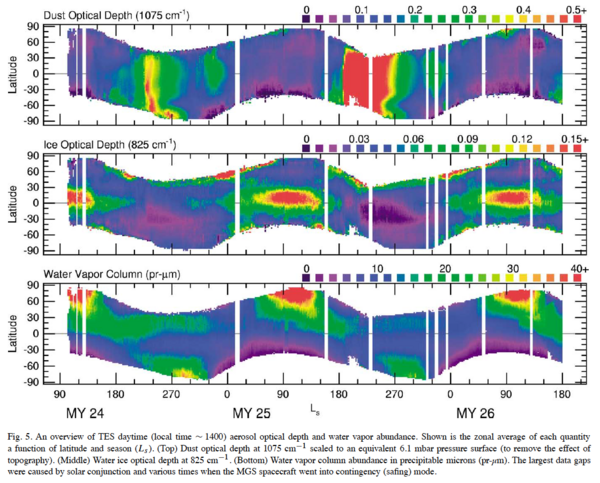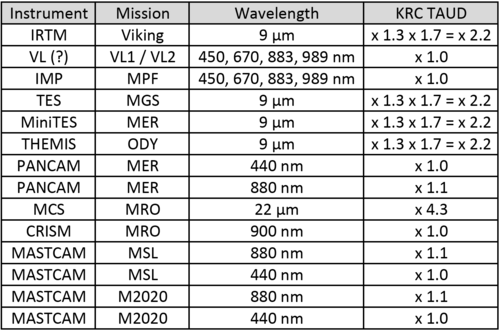KRC for Mars
Contents |
General advice about using KRC on Mars
When using KRC on Mars the best practice is to:
- Stay away from poles
- Be aware of what season it is
- Be aware of the opacity settings
Command Line Example
$ davinci dv>
dv> krc(lat = 25, lon = 125, ls = 90)
KRC Fortran Input File Example
0 0 / KOLD: season to start with; KEEP: continue saving data in same disk file
Version 222 default values. 19 latitudes with mean Mars elevations
ALBEDO EMISS INERTIA COND2 DENS2 PERIOD SPEC_HEAT DENSITY
.25 1.00 200.0 2.77 928.0 1.0275 647. 1600.
CABR AMW [ABRPHA PTOTAL FANON TATM TDEEP SpHeat2
0.11 43.5 -0.00 546.0 .055 200. 180.0 1711.
TAUD DUSTA TAURAT TWILI ARC2 [ARC3 SLOPE SLOAZI
0.3 .90 0.5 0.0 0.5 -0.00 0.0 90.
TFROST CFROST AFROST FEMIS AF1 AF2 FROEXT [FD32
146.0 589944. .65 0.95 0.54 0.0009 50. 0.0
RLAY FLAY CONVF DEPTH DRSET DDT GGT DTMAX
1.2000 .1800 2.0000 0.0 0.0 .0020 0.1 0.1
DJUL DELJUL SOLARDEC DAU LsubS SOLCON GRAV AtmCp
-1222.69 17.174822 00.0 1.465 .0 1368. 3.727 735.9
ConUp0 ConUp1 ConUp2 ConUp3 ConLo0 ConLo1 ConLo2 ConLo3
0.038640 -0.002145 0.002347 -0.000750 2.766722 -1.298966 0.629224 -0.527291
SphUp0 SphUp1 SphUp2 SphUp3 SphLo0 SphLo1 SphLo2 SphLo3
646.6275 246.6678 -49.8216 7.9520 1710.648 721.8740 57.44873 24.37532
N1 N2 N3 N4 N5 N24 IB IC
20 384 15 19 120 48 0 9
NRSET NMHA NRUN JDISK IDOWN FlxP14 FlxP15 KPREF
3 24 0 81 0 45 65 1
K4OUT JBARE Notif IDISK2 end
52 0 20 0 0
LP1 LP2 LP3 LP4 LP5 LP6 LPGLOB LVFA LVFT LkofT
F T F F F F F F F T
LPORB LKEY LSC spare LOCAL Prt76 LPTAVE Prt78 Prt79 L_ONE
T F F F F T F T F F
Latitudes: in 10F7.2 _____7 _____7 _____7 _____7 _____7 _____7 _____7
-87.50 -80.00 -70.00 -60.00 -50.00 -40.00 -30.00 -20.00 -10.00 0.00
10.00 20.00 30.00 40.00 50.00 60.00 70.00 80.00 87.50 -0.00
_____7 _____7 _____7 Elevations: in 10F7.2 ____7 _____7 _____7 _____7
3.51 2.01 1.39 1.22 0.38 0.48 1.17 1.67 1.26 0.17
-0.94 -1.28 -1.99 -2.51 -3.52 -4.08 -4.51 -4.38 -2.57 -0.00
2013 Jul 24 11:28:09=RUNTIME. IPLAN AND TC= 104.0 0.10000 Mars:Mars
104.0000 0.1000000 0.8644665 0.3226901E-01 -1.281586
0.9340198E-01 1.523712 0.4090926 0.000000 0.9229373
5.544402 0.000000 0.000000 686.9929 3397.977
24.62296 0.000000 -1.240317 0.000000 0.000000
0.000000 0.3244965 0.8559126 0.4026359 -0.9458869
0.2936298 0.1381285 0.000000 -0.4256703 0.9048783
8 0 0 'master222.t52' / Disk file name for Run 1
0/
3 10 1 'LkofT' / Temperature-dependant conductivity
0/
0/ ======================= end of run
If LkofT set to T, then
Upper material: weakly cemented particulates:
Grain: k: BasicRocks_Zoth88 2:4
Cp: Chlorite_Bert07_Fe=0.89 6:4.89
Cement: k: Limestone Zoth88 2:1
Cp: Sphene, which has relatively strong T dependence 5:0
Cement fraction 1.e-8
Yields c_0 of 0.050087, This adjusted to 0.038640 to agree with I=200 at 220 K
lower material: H2O Ice
k: koftop: 48
fit to A+B/T fit 2.766722 -1.298966 0.629224 -0.527291 <k H2O:ice3sources
Cp: koftop: @ 49,491,5,33 yields:
3.95779 > 1710.648 721.8740 57.44873 24.37532 <SpH H2O:Ice_3sources
Common Problems
The following is from Adequately Scale Dust Opacity in Advanced Tutorial
Adequately Scale Dust Opacity
First, a few definitions (From Helplist or communicated by HHK):
PTOTAL: Global annual mean surface pressure at 0 elev., Pascal[=.01mb]; If KPREF=2, global average of atmosphere plus cap system.
PTOTAL depends on the scale height you consider.
PTOTAL = 640Pa, 658Pa, 672Pa, 683Pa, 692Pa, 700Pa for scale heights H=7-8-9-10-11-12 km respectively. In reality, H oscillates over the course of a year.
KPREF: Mean global pressure control. 0 = constant 1 = follows Viking Lander curve 2 = reduced by global frost, but then N4 must be >8, and latitudes must be monotonic increasing and must include both polar regions (no warning for your failure).
TAUD: Opacity due to dust over solar wavelengths (weighted by solar spectral flux) for a column with pressure of PTOTAL at zero elevation. It is used in code: tlats8.f line 193, then 213. It can be over-ridden by using a climate file, in which case solar tau at PTOTAL is IR_opacity (from the file) / TAURAT
- If your dust opacity TAU is given for a pressure = PTOTAL (usually the case for TES/THEMIS), you do not have to scale for a different pressure.
For example, in Smith 2003, Figure 5:
Caption:Fig. 5. An overview of TES daytime (local time ∼ 1400) aerosol optical depth and water vapor abundance. Shown is the zonal average of each quantity a function of latitude and season (Ls ). (Top) Dust optical depth at 1075 cm-1 scaled to an equivalent 6.1 mbar pressure surface (to remove the effect of topography). (Middle) Water ice optical depth at 825 cm-1. (Bottom) Water vapor column abundance in precipitable microns (pr-μm). The largest data gaps were caused by solar conjunction and various times when the MGS spacecraft went into contingency (safing) mode.
In other words, if you are using a dust opacity scaled to a specific pressure = PTOTAL, no topographic correction is needed.
- If your dust opacity value is NOT given for a pressure of PTOTAL (usually the case for rovers and landers), you must first scale it to PTOTAL.
- 1 Calculate the local pressure P(z):
P0 is the reference pressure, also called PZREF. In theory, this is not PTOTAL, because the reference pressure too oscillates with Ls.
z is the elevation where the opacity measurement is made (VL1=-3.63,VL2=-4.50km, MPF=-3.68km,Spirit=-1.94km,Opportunity=-1.39km,MSL=-4.5km,InSight=-2.7km).
Z0 is the reference elevation for PTOTAL, so typically 0km.
H is the scale height in km.
- 2 Adjust the local dust opacity
The Opacity TAU at PTOTAL can then be derived using the following relation (M. Smith):
Note that if an opacity vs. Ls is provided, TAU is the visible opacity at a pressure of PTOTAL.
- 3 Adjust for wavelength
Dust opacities are given at different wavelengths in the literature. KRC works with opacity values at solar wavelengths. Use the table below to convert published opacity values to the best estimate for the visible wavelength opacity
Smith, M. D. (2004), Interannual variability in TES atmospheric observations of Mars during 1999-2003, Icarus, 167, 148-165.


